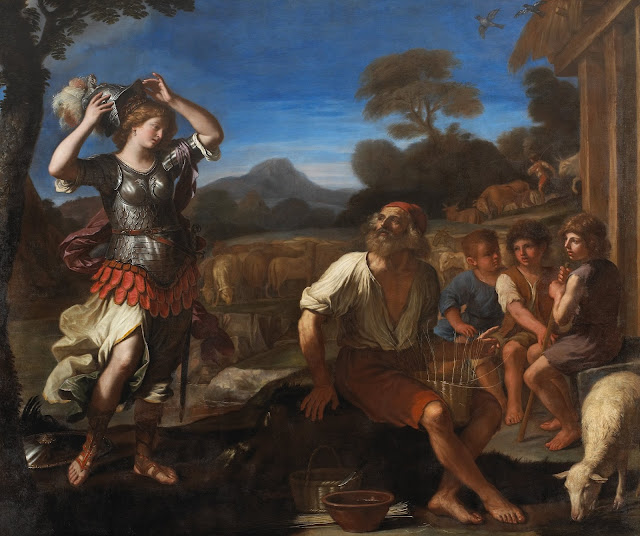 |
| Guercino Erminia finding the wounded Tancred 1619 oil on canvas Galleria Doria Pamphilij, Rome |
 |
| Giovanni Battista Pasqualini after Guercino Erminia finding the wounded Tancred 1620 engraving Rijksmuseum, Amsterdam |
 |
| attributed to Thomas Rowlandson after Guercino Erminia finding the wounded Tancred ca. 1790 etching Metropolitan Museum of Art, New York |
 |
| Guercino Erminia and the Shepherd 1619-20 oil on canvas Birmingham Museum and Art Gallery (West Midlands) |
from Gerusalemme Liberata
While he is speaking thus, Erminia quiet and intent hangs on his persuasive lips; and that wise speech, that sinks into her heart, in some part stills the tempest of her senses. After much thinking she takes up the plan of dwelling in that secret solitude at least until such time as fortune may make easier her return.
So that she says to the good old man: 'O thou of good fortune, who one time knew of evil by proof, let pity of my miseries move your heart (so may the heavens not grudge you so sweet a state); and receive me with you in this abode so pleasant, for it is my pleasure to abide with you. Perhaps it will come to pass that among these shades my heart may somewhat unburden itself of its mortal heaviness.'
– Torquato Tasso (1581), translated from Italian verse to English prose by Ralph Nash (1987)
 |
| Guercino Erminia ca. 1648 drawing National Gallery of Art, Washington DC |
 |
| Guercino Erminia and the Shepherd 1648-49 oil on canvas Minneapolis Institute of Art |
 |
| Guglielmo Morghen after Guercino Erminia and the Shepherd before 1825 etching and engraving Philadelphia Museum of Art |
 |
| Guercino Study for painting Erminia finding the wounded Tancred ca. 1650 drawing Scottish National Gallery, Edinburgh |
 |
| Guercino Erminia finding the wounded Tancred ca. 1650 oil on canvas Scottish National Gallery, Edinburgh |
 |
| Pietro Bonato after Guercino Erminia finding the wounded Tancred before 1827 engraving Harvard Art Museums |
 |
| Mattia Preti Erminia, Princess of Antioch ca. 1655-60 oil on canvas private collection |
 |
| Peter von Cornelius Erminia in Armour early 19th century drawing National Gallery of Art, Washington DC |
Scorn Not the Sonnet
Scorn not the Sonnet; Critic, you have frowned,
Mindless of its just honours; with this key
Shakespeare unlocked his heart; the melody
Of this small lute gave ease to Petrarch's wound;
A thousand times this pipe did Tasso sound;
With it Camöens soothed an exile's grief;
The Sonnet glittered a gay myrtle leaf
Amid the cypress with which Dante crowned
His visionary brow; a glow-worm lamp,
It cheered mild Spenser, called from Faery-land
To struggle through dark ways; and, when a damp
Fell round the path of Milton, in his hand
The Thing became a trumpet; whence he blew
Soul-animating strains – alas, too few!
– William Wordsworth (1838)